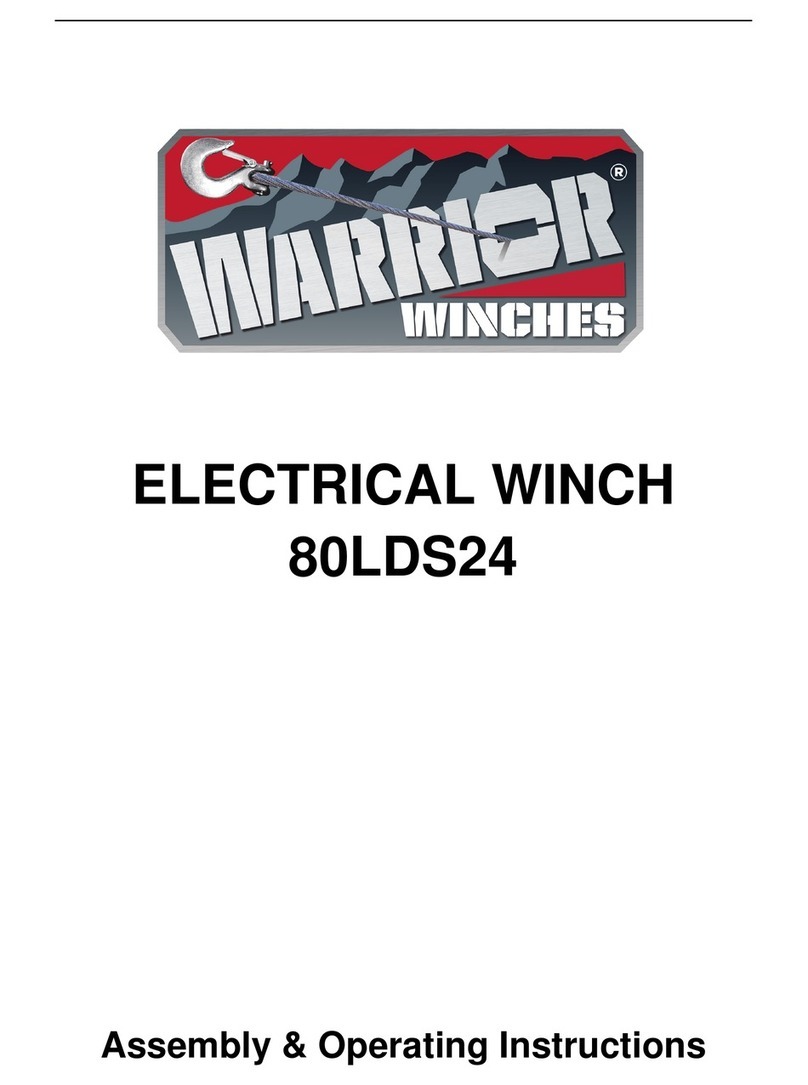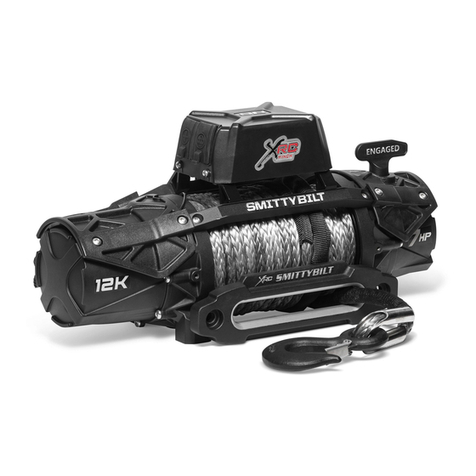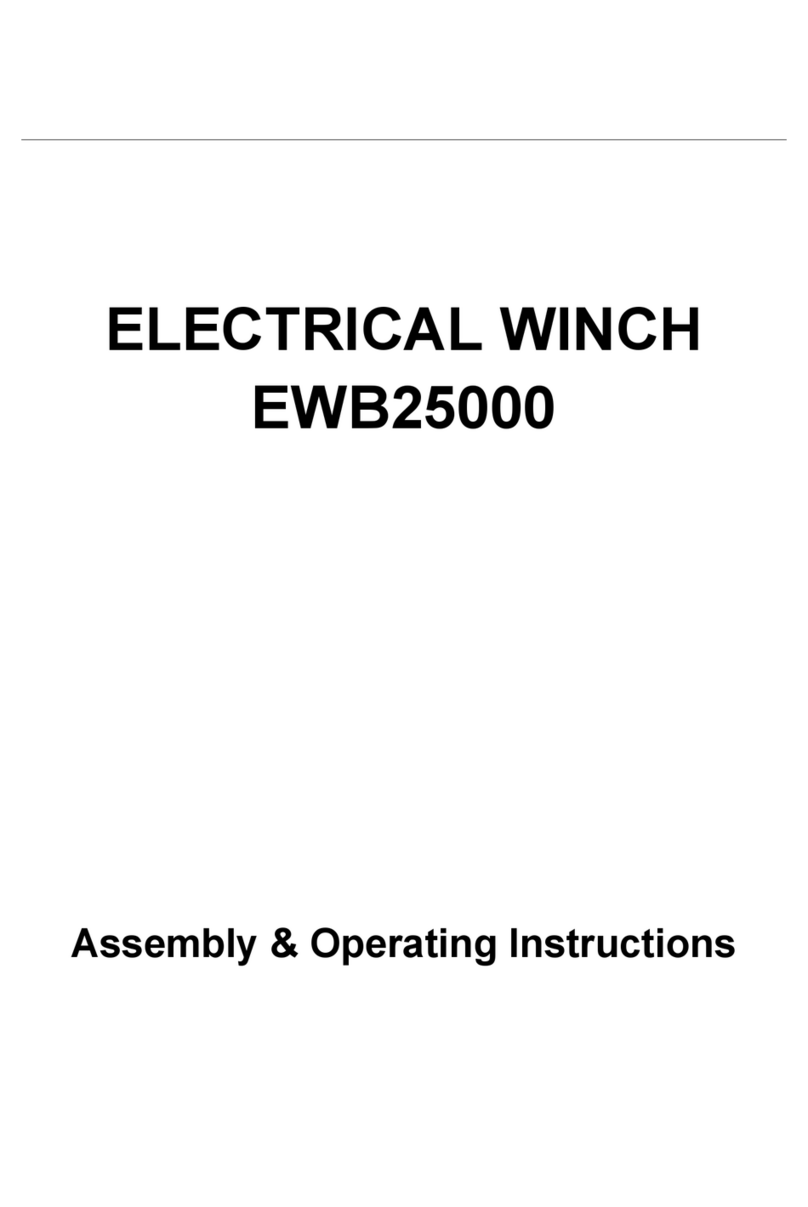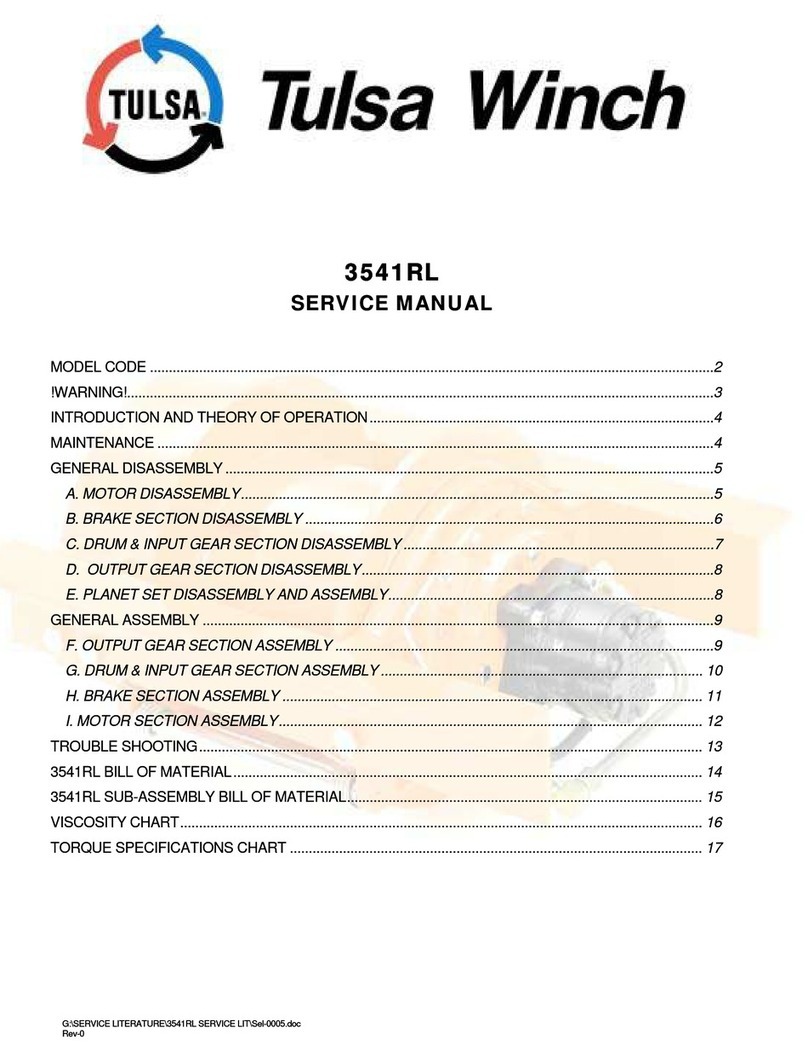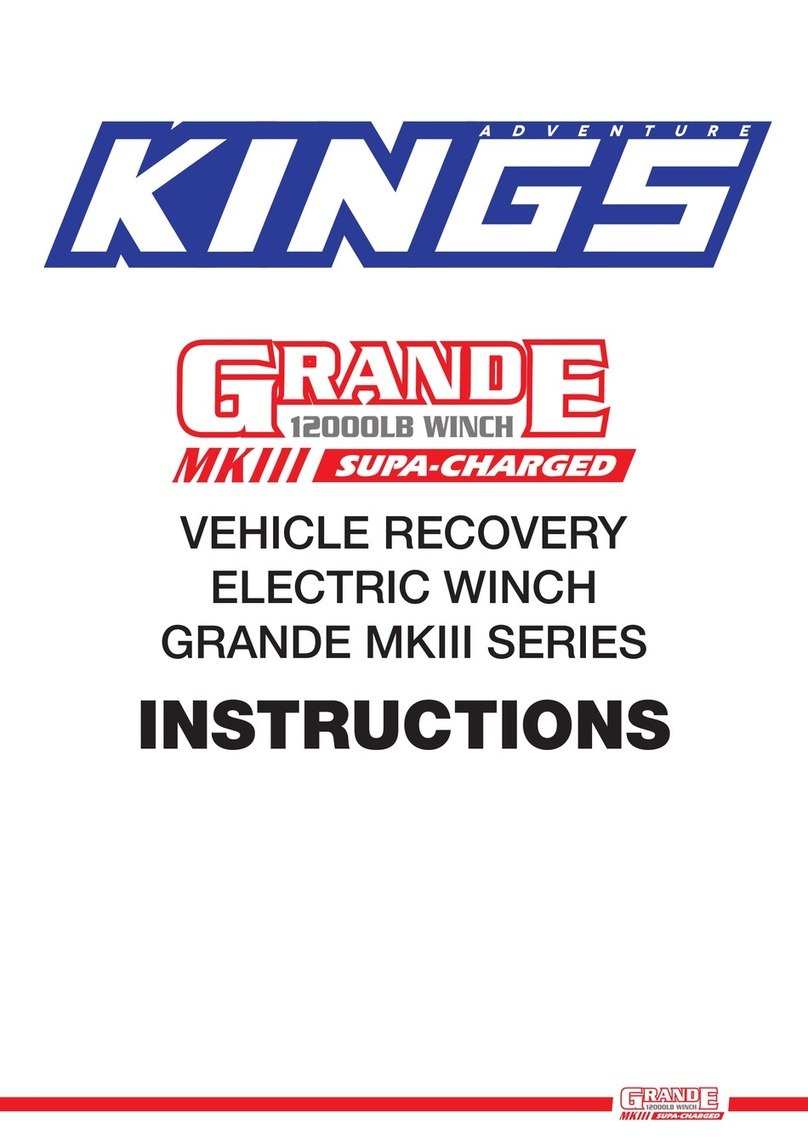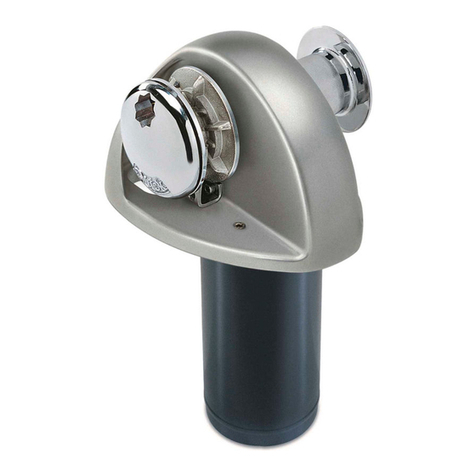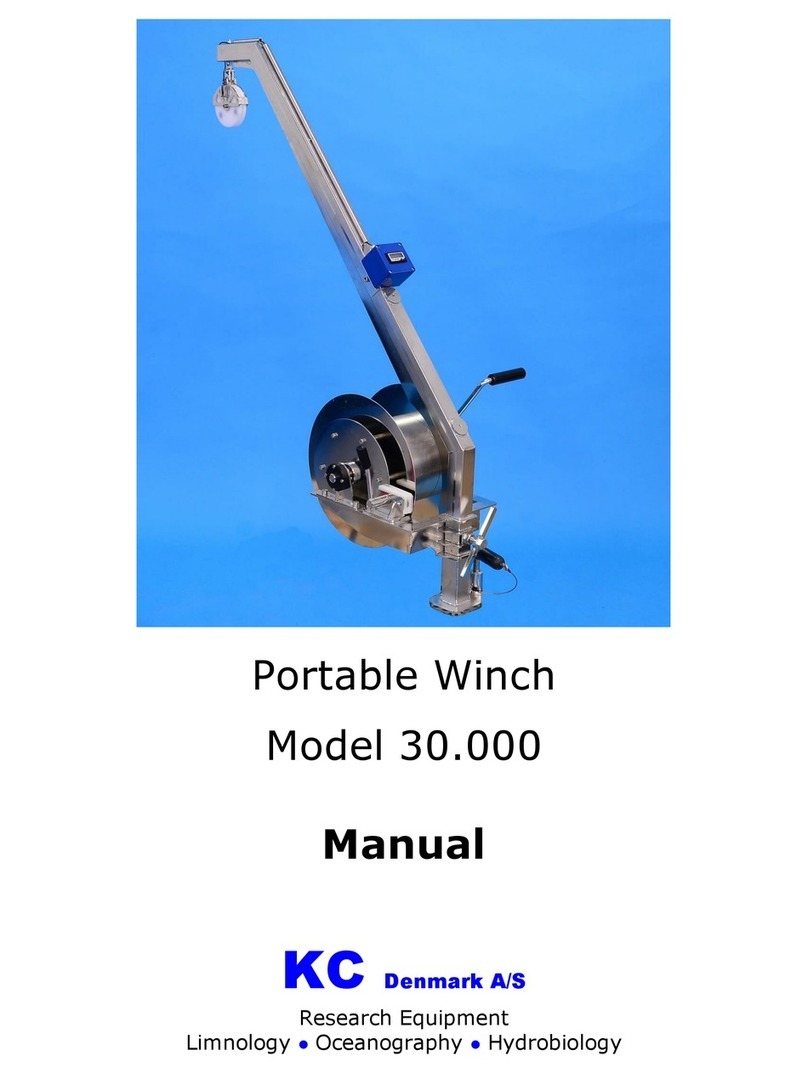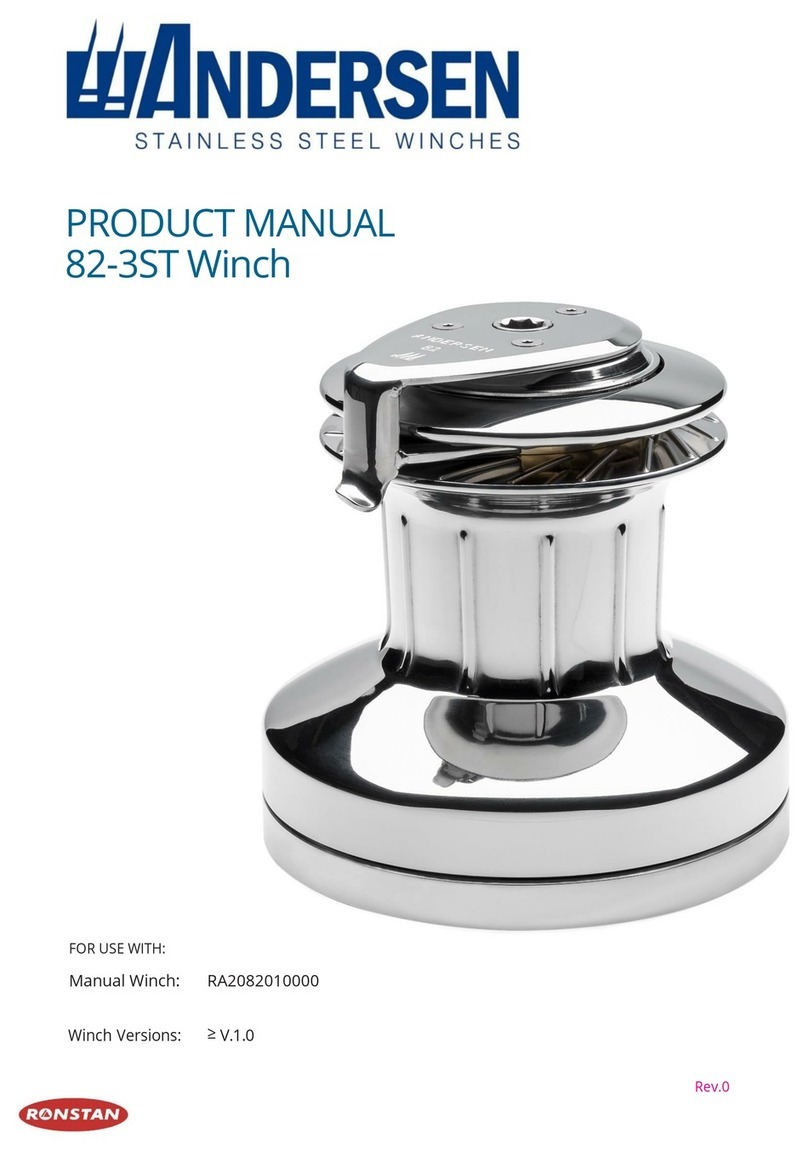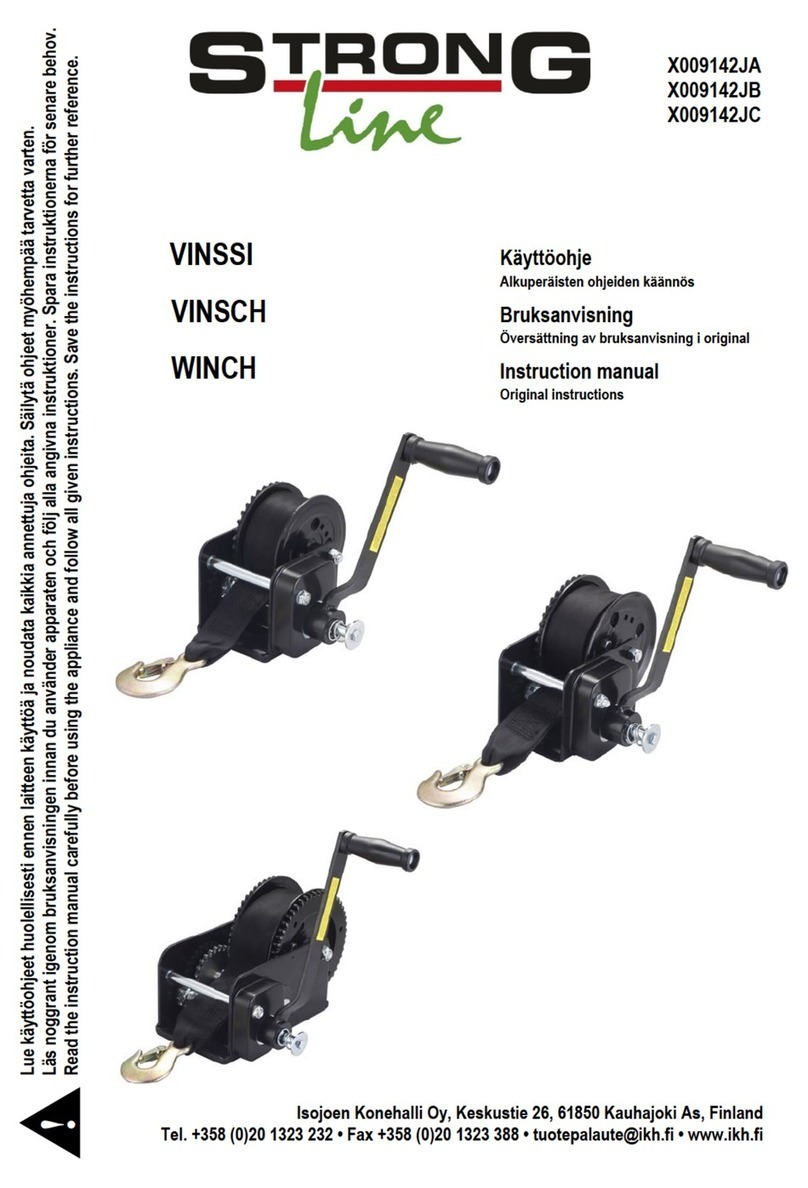Enthuze ENT4401P User manual

SAVE THESE INSTRUCTIONS
2,000-Lb. 12 Volt DC Electric ATV Winch
Owner’s Manual
WARNING: Read carefully and understand all ASSEMBLY AND OPERATION
INSTRUCTIONS before operating. Failure to follow the safety rules and other basic
safety precautions may result in serious personal injury.
Item # ENT4401P

Page 2 of 20
Thank you very much for choosing Enthuze Automotive Products!
For future reference, please complete the owner’s record below:
Serial Number/Lot Date Code: __________________________
Purchase Date: ______________________________________
Save the receipt, warranty, and this manual. It is important that
you read the entire manual to become familiar with this product
before you begin using it.
This electric winch is designed for certain applications only.
Enthuze is not responsible for issues arising from modification or
improper use of this product such as an application for which it
was not designed. We strongly recommend that this product not
be modified and/or used for any application other than that for
which it was designed.
For technical questions, please contact our customer support.
Enthuze Automotive Products
Website: www.enthuze.ca

Page 3 of 20
Table of Contents
Intended Use......................................................................................................4
Technical Specifications .....................................................................................4
Important Safety Information ............................................................................5
Specific Operation Warnings ..............................................................................7
Assembly Instructions .......................................................................................8
Before Each Use ...............................................................................................11
Operating Instructions .....................................................................................11
After Each Use..................................................................................................14
Maintenance.....................................................................................................15
Troubleshooting ...............................................................................................15
Parts List..........................................................................................................17
Replacement Parts ...........................................................................................18
Limited Warranty .............................................................................................19

Page 4 of 20
Intended Use
The Enthuze 2000-Lb. 12 Volt DC Electric ATV Winch has a permanent magnet motor
which draws less current, making it ideal for ATV use. The Differential Planetary gear
system allows for fast line speed while the automatic load-holding brake provides
maximum safety. It has free spooling for a fast line-out, a roller fairlead with nylon
bushings and an aircraft-grade wire rope.
Technical Specifications
Property Specification
Rated Single Line Pull 2,000lb (907kg)
Application Utility/Shop/ATV
Motor 12V DC 1.1 HP Permanent Magnet
Power In & Power Out Yes
Duty Cycle Rating 5% (45 Seconds at Max Rated Load; 14 minutes, 15 seconds rest)
Wired Remote
Controller
Wired, 10ft (3.04m) Long
Gear Train
Differential Planetary
Gear Ratio 153:1
Free Spool Pull and Turn
Brake Automatic Load Holding Dynamic
Drum Diameter 1.24" X 2.83" (31.5mm x 72 mm)
Hook 1/4" Clevis, with Spring-Loaded Safety Latch
Fairlead Roller with Nylon Bushings
Wire Rope Size /Type
5/32" x 50' (4.0mmX15.2m)
7X19 Galvanized Steel
Aircraft-Grade Wire Rope
Battery 12V DC Minimum 12Ah
Battery Cables 10 Gauge,6' (1.83m) long
Motor Cables 10 Gauge, 4' (1.23m) long
Mounting Bolt Pattern 3.15’’ (80mm)
Mounting Hardware Winch: 2xG8, M8-1.25X35mm (0.05” X 1.38’’ )
Overload Protection In-line Circuit Breaker
Sound Rating 85 db
Overall Dimensions
(L X D X H)
11.1"×4.6"×4.2” (282mm×117mm×106mm)
Weight 13.2lb (5.98 kg)
IP Rating IP 65 - Winch and Controls (resistant to water jets)

Page 5 of 20
Layer Rated Line pull Rope Length/ Layer
2000lb (907kg) 6’ (1.8m)
1636lb (742kg) 13.3’ (4.0m)
1384lb (628kg) 21.9’ (6.7m)
1200lb (544kg) 31.8’ (9.7m)
1058lb (480kg) 43.1’ (13.1m)
947lb (430kg) 50’ (15.2m)
First Layer of Wire Rope Performance
Line Pull
lb (kg)
Line Speed
fpm (m/min)
Amp Draw
(DC12V)
0 (0) 13.3 (4.1) 10
1000 (454) 8.3 (2.5) 55
2000 (907) 4.1 (1.2) 106
Important Safety Information
⚠
WARNING
•Read and understand all instructions. Failure to follow all instructions may result in
fire, serious injury and/or DEATH.
•The warnings, cautions and instructions in this manual cannot cover all possible
conditions or situations that could occur. Exercise common sense and caution when
using this electric winch. Always be aware of the environment and ensure that the
electric winch is used in a safe and responsible manner.
•Do not allow anyone to operate or assemble the electric winch until they have read
this manual and have developed a thorough understanding of how it works.
•Do not modify this electric winch in any way. Unauthorized modification may impair
the function and/or safety and could affect the life of the electric winch. There are
specific applications for which the electric winch was designed.
•Use the right tool for the job. DO NOT attempt to force small equipment to do the
work of larger industrial equipment. There are certain applications for which this
electric winch was designed. The tool will be safer and do the job better at the
capacity for which it was intended. DO NOT use this equipment for a purpose for
which it was not intended.
•Industrial or commercial applications must follow OSHA requirements.

Page 6 of 20
⚠
WARNING
WORK AREA SAFETY
•Inspect the work area before each use. Keep work area clean, dry, free of clutter and
well-lit. Cluttered, wet or dark work areas can result in injury. Using the electric
winch in confined work areas may put you dangerously close to other cutting tools
and rotating parts.
•Keep children and bystanders away from the work area while operating the tool. Do
not allow children to handle the electric winch.
⚠
WARNING
PERSONAL SAFETY
•Stay alert, watch what you are doing and use common sense when operating the
electric winch. Do not use the electric winch while you are tired or under the influence
of drugs, alcohol or medication. A moment of inattention while operating the tool may
result in serious personal injury.
•Dress properly. Do not wear loose clothing, dangling objects or jewelry. Keep your
hair, clothing and gloves away from moving parts. Loose clothes, jewelry or long hair
can be caught in moving parts. Air vents on the tool often cover moving parts and
should be avoided.
•Wear the proper personal protective equipment when necessary. Use ANSI Z87.1
compliant safety goggles (not safety glasses) with side shields, or when needed, a
face shield. Use a dust mask in dusty work conditions. Also use non-skid safety
shoes, hardhat, gloves, dust collection systems and hearing protection when
appropriate. This applies to all persons in the work area.
•Do not overreach. Always keep proper footing and balance.
⚠
CAUTION
ELECTRIC WINCH USE AND CARE
•Inspect before every use, do not use if damaged or parts loose. Examine the winch
for structural cracks, bends, damage, frayed or kinked rope, and any other conditions
that may affect the safe operate of the winch. Do not use the winch even if minor
damage appears. A kink permanently weakens the rope. Even after it is straightened
out, kinked rope can fail suddenly and must not be used.
•Do not force the electric winch. Products are safer and do a better job when used in
the manner for which they are designed. Plan your work and use the correct product
for the job.
•Store the winch in a dry, secure place out of the reach of children when it is not in
use. Inspect the tool for good working condition prior to storage and before re-use.
•Use only accessories that are recommended by the manufacturer for use with your
electric winch. Accessories that may be suitable for one product may create a risk of
injury when used with another tool. Never use an accessory that has a lower
operating speed or operating pressure than the tool itself.

Page 7 of 20
Specific Operation Warnings
⚠
WARNING
GENERAL SAFETY
•To prevent injury or property damage, read and understand all instructions before
operating winch.
•Wear ANSI Z87.1 compliant safety goggles and heavy duty leather work gloves
during operation.
•Do not exceed the rated load capacity. Be aware of dynamic loading! Sudden load
movement may briefly create excess load, causing product failure.
INSTALLATION SAFETY
•Choose a mounting location that can support the winch and rated load capacity.
•Do not weld mounting bolts.
•Use supplied power cords and rope listed in manual only. Do not use thinner/longer
cables or link multiple cables together.
•Keep hands clear of winch rope, hook loop, hook and fairlead opening during
installation, operation, and when spooling in or out.
•Wrap the rope under 500 lbs. of tension before use. Otherwise, the rope may bind
during operation.
•Do not route electrical cables near sharp edges or parts that will move or become
hot.
•Work in a well-ventilated area. Explosive hydrogen gas can accumulate and explode
when ignited by a spark or open flame.
•Only connect to a clean, corrosion-free battery.
•Remove all jewelry and metallic objects before working near battery.
WINCHING SAFETY
•Inspect winch rope, hook, and slings before operating winch. Frayed, kinked or
damaged winch rope must be replaced immediately. Damaged components must be
replaced before operation.
•Do not maintain power to the winch if the motor stalls. Verify the load is within the
rated capacity for the wire rope layer. Make sure the battery is fully charged. Use
double line rigging whenever possible.
•Do not engage or disengage clutch while under load.
•Always ensure hook latch is closed and not supporting load.
•Never apply load to hook tip or latch. Apply load only to the center of hook.
•Never use a hook that has been bent, warped or twisted.
•Keep clear of fairlead when operating. Do not try to guide rope.
•Do not place any fingers through the hook. Fingers may be caught and get pulled
into the fairlead or drum. Use the included strap to hold the hook instead.
•Stay out of the direct line that the rope is pulling. If it slips or breaks, it will create a
whiplash effect. Utilize a winch dampener to help absorb the force released if the
rope breaks.

Page 8 of 20
•Do not use for overhead hoisting. This winch is intended to be used for pulling only.
•Use a spotter to assist you with safe operation of the winch. Make sure the spotter
is out of the way of the vehicle and the rope before activating the winch.
•Do not use the hand crank, if equipped, to assist the winch.
•Do not use vehicle to pull on the rope and assist the winch.
•Do not use to transport people or animals.
•Disconnect battery cables before working near the rope, drum, fairlead or load to
prevent accidental starting.
•Keep rope straight to avoid kinking the rope.
•Keep children and bystanders away while operating.
•Hook onto the object using a pulling point, tow strap or chain. Do not wrap the rope
around the object and hook onto the rope itself.
•Do not use a recovery strap while winching.
•Secure the load after moving. Do not lock the mechanism.
•Keep at least 5 full turns of rope on the drum.
•Keep clear of the rope, hook, and load while winching. Do not step over the rope or
apply pressure to the rope under tension. The rope might break and cause personal
injury.
•If the rope begins to get entangled, stop the winch immediately and release the
rope using the switch.
•Only winch with the winching vehicle’s transmission placed in neutral. Winching with
a vehicle’s transmission in gear or park may damage the transmission. A vehicle’s
transmission is not designed to handle this type of load.
•Do not operate the winch on extreme slopes. Do not exceed 45° from center line of
vehicle for a roller fairlead. For a Hawse fairlead, the angle should be as close to
vehicle center line as possible.
•People with pacemakers should consult their physicians before use. Electromagnetic
fields near a heart pacemaker could cause pacemaker interference or pacemaker
failure.
•Remove all obstacles before operation.
•Always use supplied hook strap whenever spooling winch rope in or out, during
installation and during operation.
•Always take time to use appropriate rigging techniques for winch pull.
Assembly Instructions
⚠
WARNING
Read the entire Important Safety Information section at the beginning of this manual,
including all text under subheadings, before setting up or using this electric winch.

Page 9 of 20
Mounting the Winch
1. The mounting plate must be rated to at
least
the winch’s
capacity.
2.
Align the winch perpendicular to the center line of
the
vehicle at the desired
location and
mark the
locations
of the winch base holes. Compare the
dimensions
of the marked holes.
3. Before drilling, verify that the
installation
surface has no hidden components
or
structural pieces that will be
damaged.
Note: This winch can generate extreme
force
s
.
Select
a location that can
withstand the rated capacity
without
damage or weakening. Steel reinforcement
plates
may
be needed or a certified welder may need to weld
on
additional
bracing, depending on the mounting
location.
4. Drill holes appropriate for the
hardware
at the marked
locations.
5. Install the winch using
hardware
described
under the
specifications table.
Mounting the Solenoid Assembly
1. Mount the solenoid box in proper location so that:
a) The winch components are close enough to each other to allow wires to be
routed properly.
b) The vehicle component operation is not interfered with.
c) The vehicle components are not damaged by drilling or driving screws.
d) The winch components will not be damaged by stresses caused by vehicle
operation.
2. Mark the location where the screw holes will be.
3. Verify that the installation surface has no hidden components or structural pieces
that will be damaged before drilling.

Page 10 of 20
4. Drill pilot holes for the mounting screws.
5. Secure in place with mounting screws.
Wiring
To prevent serious injury from explosion (sparking at the battery connection), disconnect
the battery cables before making other wiring connections.
To prevent serious injury from leaking battery acid, do not use a dirty, corroded or
leaking battery. Only use a 12V automotive (or equivalent) battery, in good condition.
1. Plan a route for the wiring from the planned winch location to the battery. This route
must be secure and out of the way of moving parts, road debris, or any possibility of
being damaged by operation or maintenance of the vehicle. For example, you may
wish to route the wires under the vehicle, attaching it to the frame using suitable
fasteners. Do not attach the wires to the exhaust system, drive shaft, emergency
brake cable, fuel line, or any other components which may damage the wiring
through heat or motion, or create a fire hazard.
2.
If you drill through the bumper or any part of the body to route the wires, be sure to
install a rubber grommet in the hole to prevent fraying the wires.
3. Route the cables from the solenoid to the battery and from the solenoid to the
winch, following the precautions discussed above. See the following picture.
Wiring Connection
4. Attach the short wires from the remote to the terminals on the motor.
5. Attach the red battery cable directly to the positive terminal on the battery.
6. Attach the black battery cable directly to the negative terminal of the battery.
Note: The attachment of the motor cables determines the operation
of the remote's button. After the unit is mounted and powered,
check the direction of the Power In and Power Out on the remote
button. If you wish to change the direction on the remote,
disconnect the battery cables from the battery, switch the motor
cable connections on the motor assembly, then reconnect the
battery cables.
Black
Black
Red
Red
Battery
Tethered Remote
Motor

Page 11 of 20
Preparing the Wire Rope
1. The wire rope must be properly coiled under tension to be able to support a load
without damage.
2. Uncoil the wire rope, except for 5 full wraps.
3. Recoil the rope back into the winch under at least 500 lb. of tension.
Before Each Use
⚠
WARNING
•Inspect the winch rope, hook, and slings before operating the winch. Frayed, kinked
or damaged winch ropes must be replaced immediately. Damaged components
must be replaced before operation.
•Wrap the rope under 500 lbs. of tension before use. Otherwise, the rope may bind
during operation.
•Work in a well-ventilated area. Explosive hydrogen gas can accumulate and explode
when ignited by a spark or open flame.
•Remove all jewelry and metallic objects before working near batteries.
Operating Instructions
⚠
WARNING
•Read the entire Important Safety Information section at the beginning of this
manual, including all text under subheadings, before setting up or using this winch.
•The instructions that follow are basic guidelines only and cannot cover all situations
encountered during use. The operator and assistants must carefully plan usage to
prevent accidents.
Clutch Operation
1. The position of the pin in the shaft determines whether the clutch is engaged or not.

Page 12 of 20
2. To change clutch position:
a) Pull clutch knob out
b) Turn it 90°while it is pulled out, then release it.
Basic Operation
Note: If a winch is to be used to pull a vehicle, it should optimally be rated to a
single line pull at least twice the vehicle’s weight.
1. Examine the rope. Do not use the winch if the rope is frayed, kinked, or damaged.
2. Fully charge the vehicle’s battery.
3. Check the winch's electrical connections. All connections must be tight and clean.
4. Put the vehicle's transmission in ‘neutral’.
5. If the vehicle (where the winch is mounted) is not supposed to be moved, engage
the emergency brake and block the wheels using wheel chocks (sold separately).
6. To pull out the rope, move the clutch control to the released position (same as photo
in Step 2 on Page 11), slide the loop of the hook strap over the hook, then pull on
the hook strap to pull out the rope.
7. Hook onto the object using a pulling point, tow strap, tree strap or chain. See the
following picture.
Do not wrap the rope around the object and hook onto the rope itself. This can damage
the object being pulled, and kink or fray the rope.
8. The attachment point must be centered in loop of the hook and the hook’s safety
clasp must be fully closed. See the following picture.
⚠
WARNING
Leave at least five full turns of rope on the drum.

Page 13 of 20
9. Do not use a recovery strap while winching. They are designed to stretch and can
suddenly whip back towards the operator during a winching operation.
10. Place a heavy rag or carpet (sold separately) over the rope span, 6 feet from the
hook, to help absorb the force released if the rope breaks.
11. Move the clutch control to the engaged position. See the instruction for your winch
model under clutch operation.
⚠
WARNING
Do not allow anyone to stand near the rope, or in-line with the rope behind the winch
while it is under power. If the rope should slip or break, it can suddenly whip back
towards the winch, causing a hazard for anyone in the area. Stand to the side while
winching.
12. Operate the wired remote controller briefly to ensure the controls work properly. If
operation is reversed, the power cables may be connected backwards. Correct any
such issue before use.
13. When it is safe to do so, use the power switch on the wired remote controller to
retract the rope, and winch the item as desired. To prevent damage, do not power
the hook all the way into the fairlead.
14. Do not operate the winch at extreme angles. Do not exceed the angles shown below
for a roller fairlead. For a Hawse fairlead, the angle should be as close to straight as
possible.
15. If the object to be pulled must be pulled at an angle in relation to the winch, use a
pulley (sold separately) and an anchor point directly in front of the winch (see
illustration) to keep the rope pulled straight.

Page 14 of 20
⚠
WARNING
Stop the winch and release tension on the rope before moving the rag or carpet placed
on it.
16. Do not continue use of the winch until the battery is completely run down. Stop
before it reaches that point.
17. When possible, keep the engine running while using this winch to continually
recharge the battery and prevent the battery from being drained so much that the
vehicle cannot start. However, you should use extreme caution when working
around a running vehicle and ONLY operate a vehicle in an outdoor area.
Note: Do not use the winch in a constant duty application; it is designed for
INTERMITTENT USE ONLY. Keep the duration of the pulling job as short as possible. If
the motor becomes very hot to touch, stop and let it cool down for several minutes. Do
not pull for more than one minute at or near the rated load. Do not maintain power to
the winch if the motor stalls. Double-line rigging will help prevent overloading and should
be used whenever practical.
18. When finished pulling the load, reverse the direction of the winch just enough to
release tension on the rope so that you can unfasten the hook from the load and reel
in the rope.
19. Disconnect the wired remote controller (if equipped) after use.
Duty Cycle (Duration of Use)
Avoid damage to the winch by not winching for more
than the prescribed duty cycle time.
The duty cycle defines the amount of time, within a
15-minute period, during which a winch can operate at
its maximum capacity without overheating. For
example, this winch with a 5% duty cycle at its
maximum load must be allowed to rest for at least 14
minutes, 15 seconds after every 45 seconds of
continuous operation. Failure to carefully observe duty
cycle limitations can easily over-stress a winch and
contribute to premature winch failure.
After Each Use
⚠
WARNING
Wipe external surfaces of the winch with a clean cloth.

Page 15 of 20
Maintenance
⚠
WARNING
•To prevent serious injury from accidental operation, disconnect the battery cables
before performing any inspection, maintenance or cleaning procedures
•To prevent serious injury from winch failure, do not use damaged equipment. If an
abnormal noise or vibration occurs, have the problem corrected before further use.
•Lubricate the wire rope occasionally with a light oil.
•The winch‘s internal mechanism is permanently lubricated. Do not open the
housing. However, if the winch is submerged, it should be opened, dried, and re-
lubricated by a qualified technician as soon as possible to prevent corrosion.
Troubleshooting
⚠
WARNING
•Follow all safety precautions whenever diagnosing or servicing the tool.
•Disconnect power supply before service.
Use the table below to troubleshoot problems before contacting service personnel. If the
problem continues after troubleshooting, contact us at info@enthuze.ca for assistance.
Failure Possible Cause Corrective Action
Motor
overheats 1. Incorrect power cords
2. Winch is running too long
1. Use only supplied power cords
2. Allow winch to cool down
periodically
Motor does
not turn
on
1. Remote battery is dead
2. Loose battery cable
connections
3. Vehicle battery needs charging
4. Solenoid is malfunctioning
5. Remote damaged.
6. Defective motor
7. Water has entered motor
8. Internal damage or wear
1. Replace remote battery
2. Tighten nuts on all cable connections
3. Fully charge battery
4. Tap solenoid to loosen
contacts. Apply
12
volts to
coil terminals directly. A
clicking indicates proper
activation
5. Replace remote
6. Check for voltage at armature
port with switch pressed. If
voltage is present, replace
motor
7. Allow to drain and dry. Run
in short bursts without
load until completely dry
8. Have technician service winch
Motor runs
but rope Clutch not engaged
Move the clutch handle to the engaged
position. If problem persists, a qualified
technician needs to check and repair.

Page 16 of 20
drum does
not turn
Motor runs
slowly or
without
normal
power
1 Insufficient current or voltage
2. Loose or corroded
battery cable connections
3. Incorrect power cords
1. Battery weak, recharge it. Run
winch with vehicle motor running
2. Clean, tighten, or replace
3. Use only supplied power cords
Motor runs
in one
direction
only
1. Defective or stuck solenoid
2. Remote damaged
1. Tap solenoid to loosen contacts
Repair or replace solenoid
2. Replace remote

Page 17 of 20
Parts Diagram
Parts List
Part Number
Description
Quantity
1
Motor
1
2
Gear Ring
1
3
Planetary Gear Assembly
1
4
Rotator Gear
1
5
Drum Support Plate
1
6
Pan Head Screw M6x16
4
7
Drum Assembly
1
8
Screw M5x8
1
9
Spline
1
10
Spring
1
11
Clutch Assembly
1
12
Tension Plate
1
13
Pin 2.5 x 12
1
14
Baseplate
1
15
Bushing
1
16
Clutch Knob
1
17
Hex Socket Screw M6x 16
2

Page 18 of 20
Part Number
Description
Quantity
18
Nut M8
2
19
Flat gasket M8
2
20
Spring washer M8
2
21
Hexagon bolt M8 x 35
2
22
Screw M5 x 12
2
23
Hex Flange Nut M5
2
24
Wired Remote Controller
1
25
Red Strap
1
26
Cable Assembly
1
Replacement Parts
•For replacement parts and technical questions, please call Customer Service at
info@enthuze.ca
•Not all product components are available for replacement. The illustrations provided
are a convenient reference to the location and position of parts in the assembly
sequence.
•When ordering parts, the following information will be required: item description,
item model number, item serial number/item lot date code, and the replacement part
number.
•The distributor reserves the rights to make design changes and improvements to
product lines and manuals without notice.

Page 19 of 20
Limited Warranty
Enthuze Automotive Products (“Us” or “We”) warrants to the original purchaser only
("You'' or “Your”) that the Enthuze product purchased will be free from material defects
in both materials and workmanship, normal wear and tear excepted, for a period of one
year from date of purchase. The foregoing warranty is valid only if the installation and
use of the product is strictly in accordance with product instructions. There are no other
warranties, express or implied, including the warranty of merchantability or fitness for a
particular purpose. If the product does not comply with this limited warranty, Your sole
and exclusive remedy is that We will, at our sole option and within a commercially
reasonable time, either replace the product or product component without charge to You
or refund the purchase price (less shipping). This limited warranty is not transferable.
Limitations on the Warranty
This limited warranty does not cover: (a) normal wear and tear; (b) damage through
abuse, neglect, misuse, or as a result of any accident or in any other manner; (c)
damage from misapplication, overloading, or improper installation; (d) improper
maintenance and repair; and (e) product alteration in any manner by anyone other than
Us, with the sole exception of alterations made pursuant to product instructions and in a
workmanlike manner.
Obligations of Purchaser
You must retain Your product purchase receipt to verify date of purchase and that You
are the original purchaser. To make a warranty claim, contact info@enthuze.ca,
identify the product by make and model number, and follow the claim instructions that
will be provided. The product and the purchase receipt must be provided to Us in order
to process Your warranty claim. Any returned product that is replaced or refunded by Us
becomes our property. You will be responsible for return shipping costs or costs related
to Your return visit to a retail store.
Remedy Limits
Product replacement or a refund of the purchase price is Your sole remedy under this
limited warranty or any other warranty related to the product. We shall not be liable for:
service or labor charges or damage to Your property incurred in removing or replacing
the product; any damages, including, without limitation, damages to tangible personal
property or personal injury, related to Your improper use, installation, or maintenance of
the product or product component; or any indirect, incidental or consequential damages
of any kind for any reason.
Assumption of Risk
You acknowledge and agree that any use of the product for any purpose other than the
specified use(s) stated in the product instructions is at Your own risk.
Table of contents
Popular Winch manuals by other brands
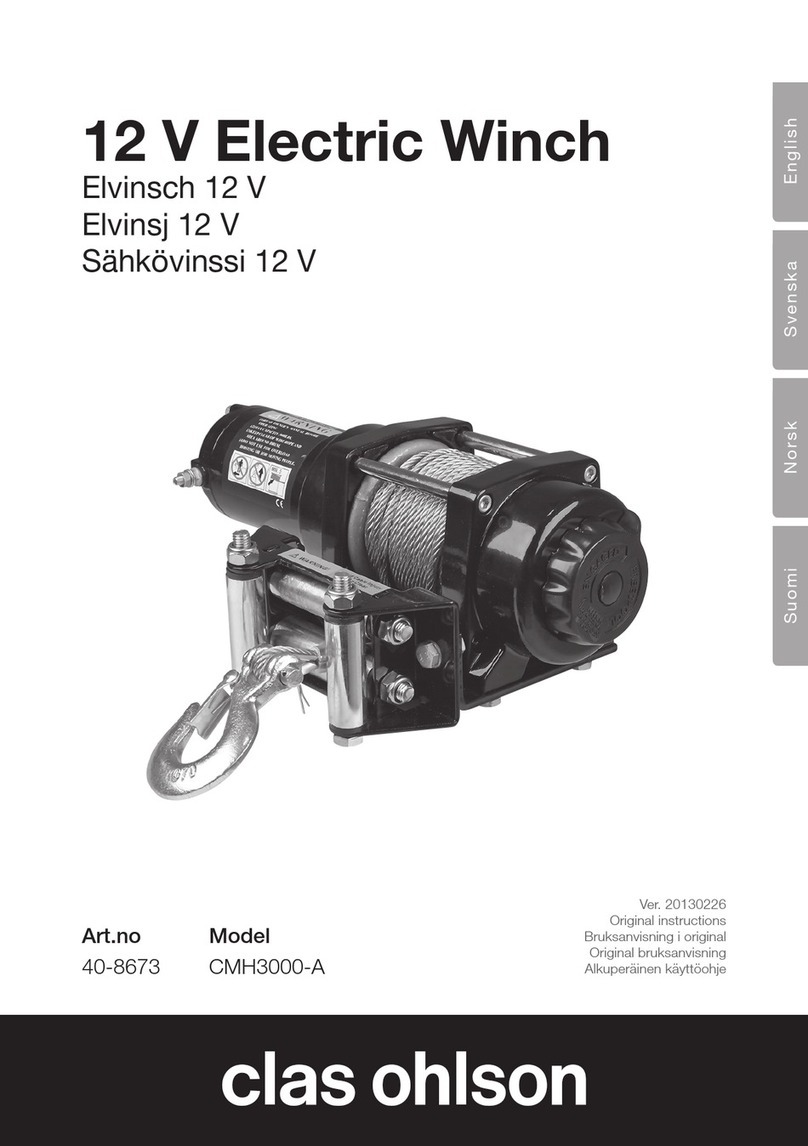
Clas Ohlson
Clas Ohlson CMH3000-A Original instructions

Champion Power Equipment
Champion Power Equipment SUP2500 Assembly & operating instructions

Kolpin Outdoors
Kolpin Outdoors POLARIS SPORTSMAN Assembly & owners manual
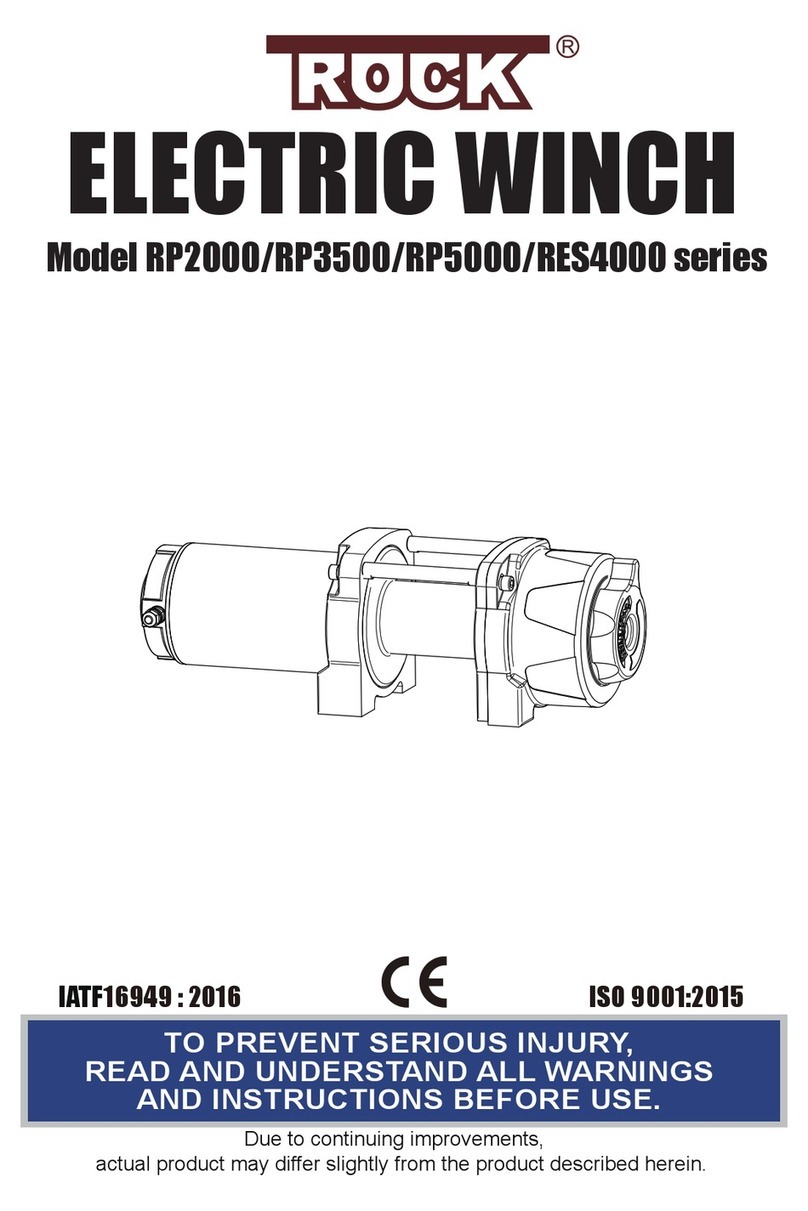
ROCK
ROCK RP2000 Series manual
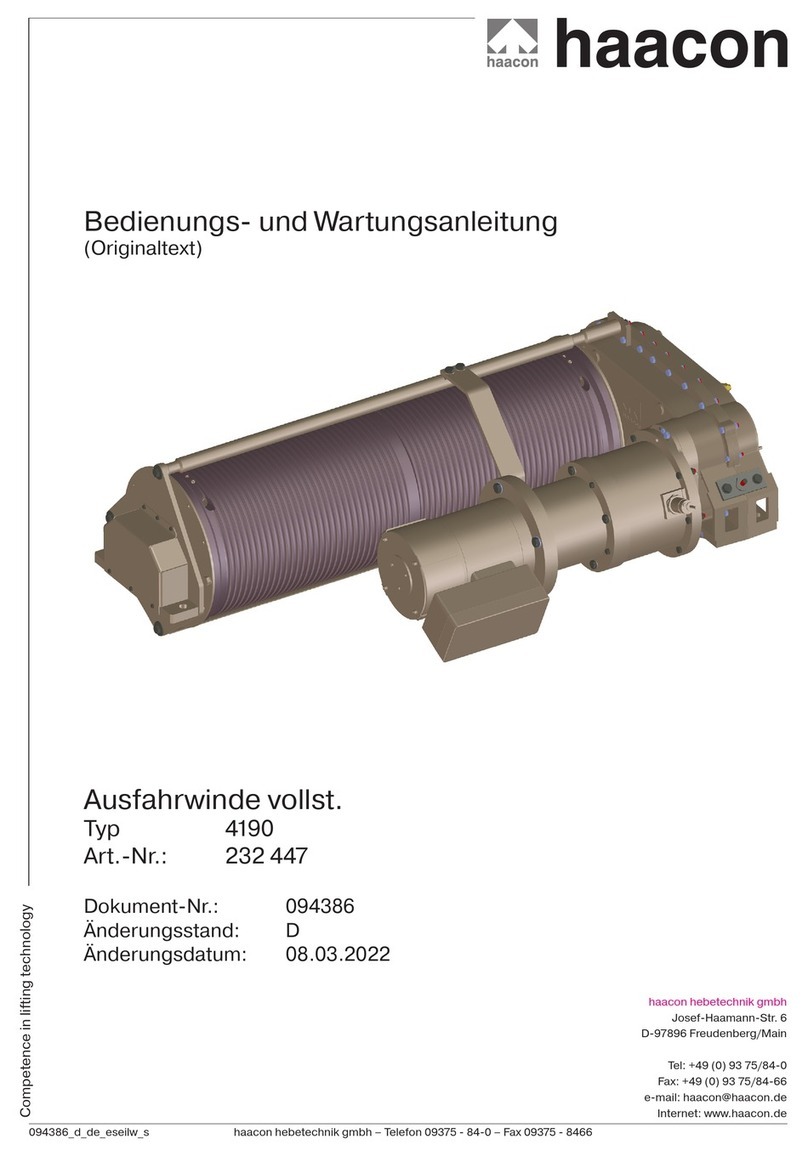
haacon
haacon 4190 Operating and maintenance manual

Warrior Winches
Warrior Winches S12000 Assembly & operating instructions


